The Best New York Style Pizza Dough and 14 Tips for Success!!
I’ve been making a lot of this NY style pizza dough recipe …. The obsession started a while back, and I’ve finally found a recipe that I love the best! After years of experiments (and I mean years!), I am now using this recipe based on recommendations from the many fine pizza makers at www.pizzamaking.com and the late great Dough Doctor, Tom Lehmann.

Making Pizza Dough at Home
Making NY style pizza dough is definitely somewhat of an art form. There are so many variables that can be changed aside from the ingredients alone. For example, these variables include:
- oven temperature
- temperature of the water used to make the dough
- proofing methods (room temp vs cold rise)
- order of adding the ingredients (yes, this makes a big difference!)
- mixing time
- use of autolyse
- use of poolish (I don’t do this or the one before, although I have in the past)
And then of course, the toppings which can be simple or as complex as you’d like. But don’t worry too much about all of this – my method is easy and straightforward. Plus, you will make better dough than 99% of the pizza chains out there. You will not want take out anymore!
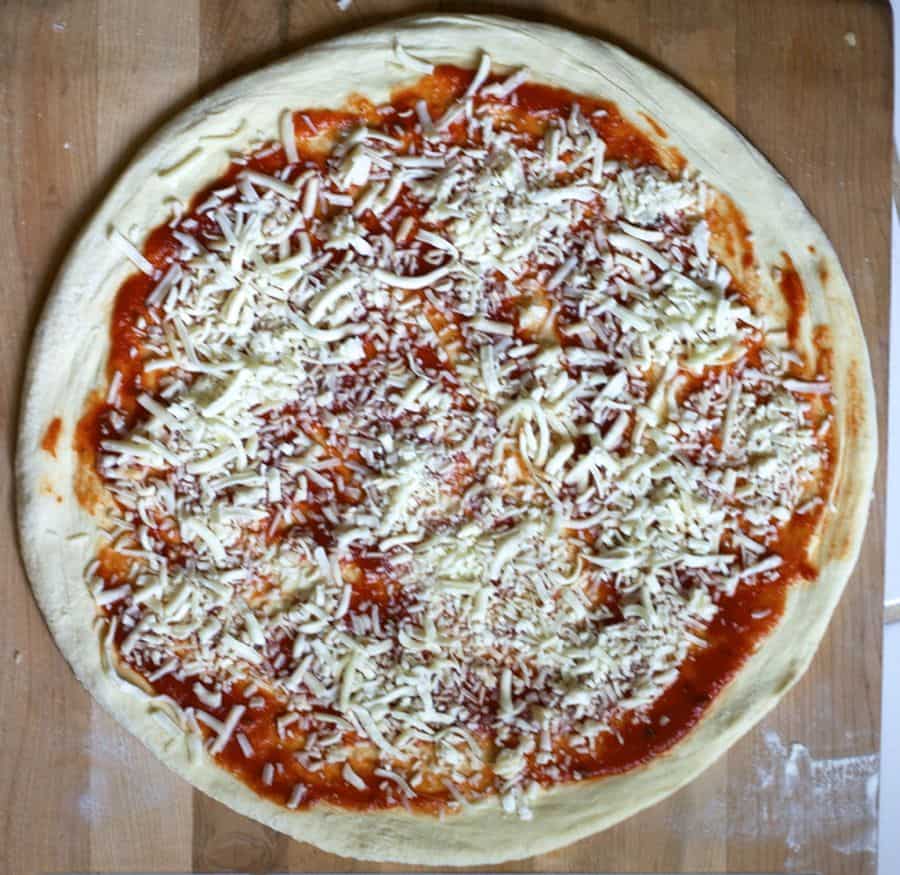
My Favorite Pizza Dough: The Big Secret (How You Proof the Dough)
My all-time favorite dough is NY style dough, which really is classic pizza dough that is stretched out into a thin crust pizza. This type of pizza dough contains water, flour, salt, instant yeast, and olive oil (and sugar especially when baking in a home oven, to help browning).
After it is mixed, it is proofed (left to rise/ferment) in the refrigerator for a minimum of 24 hours and up to 72 hours (it can also be frozen) – this is the big secret. I’ve used the dough up to 5 or 6 days afterwards, so you can essentially prepare dough for the week.
This recipe produces a crisp yet foldable crust that is tender, light, and flavorful and will make enough for four 14-inch pizzas. You can easily double or half the recipe to make 2 or 8 pizzas.

Fourteen Tips for Success
Tip 1: Choosing the flour
Use high-quality flour – I like to use King Arthur’s all purpose or bread flour; higher protein (ie, bread) flours work best. However, I prefer all-purpose flour because I like a lighter, airy crust.
Tip 2: Adding the yeast
Do not add instant dry yeast (IDY) directly to cold or cool water – you may shock the yeast (add the IDY to your flour instead) (please note that IDY differs from active dry yeast, which must be activated by adding it to water).
Tip 3: How much yeast?
Use only enough yeast to “get the job done” – yeast eats the sugar in your flour to produce its leavening effects – I find that if you use too much, your dough will be tasteless (this is just my opinion); however, it is a fact, that too much yeast can make your dough taste bad. Most recipes out there, some of them in well known, published books contain too much yeast!
Tip 4: Cold ferment that pizza dough!
Always use your refrigerator. The best NY style doughs “ferment” or “cure” in the refrigerator for at least 24 hours and up to 48 72 hours. This is called a “cold rise” (vs warm rise on your kitchen counter).
The refrigerator is used to retard (or slow) the dough’s fermentation, allowing that distinctive flavor to come through (ever wonder why some pizza crust tastes different than others, despite the fact that they are both made from just about the same exact ingredients? – this is a big reason why!)
When your dough rises too quickly, the flavor will not develop optimally. Slow rise = MUCH better flavor.
Tip 5: Weigh those ingredients!
Use a scale to weigh the flour instead of using a measuring cup – it is much more accurate and will yield superior results. I’ll admit, I resisted doing this for a loooong time. Just do it. You’ll be glad you did and your dough will be more consistent and much improved.
Tip 6: Add oil last
Mix the oil in as the last step, after the flour has all been incorporated. This is important to allow the flour to hydrate properly.
Tip 7: Flour your dough balls
Before tossing or opening your dough balls, flour them *very* well on each side (if you are a beginner) to ensure they do not stick to your counter or pizza peel. I sometimes use a bit more flour after I begin spreading them.
Tip 8: Keeping those rims a bit puffy
Take care not to “degas” the rim of your pizza as you are spreading your dough! Do NOT ever use a rolling pin! There are many different methods to spread/open your dough ball. I hope to add a few pictures someday of this process.
Tip 9: Baking pizza in a home oven
Ensure that your oven is preheated for a sufficient amount of time (about 1 hour) and bake the pizza within 6 to 8 inches of the top of your oven (ie, your broiler) so that the tops browns sufficiently in conjunction with the bottom of the pizza.
Do not place the stone near the bottom of your oven. I made this mistake for too many years.
After your stone has been preheated sufficiently, the heat from the stone will cook the pizza from the bottom and you can switch the broiler on if you find you need more browning on the top (I now use the broiler to bake my pizzas…more on this sometime in the future).
If you find that your cheese is browning well before your rim attains sufficient color, use partially frozen cheese (ie, place shredded cheese in the freezer while the oven is heating up) and cold sauce or you can drizzle just a bit of olive oil on top of cheese.
Tip 10: Use a pizza stone or steel
Use a pizza stone if you have one. The stone with draw moisture out of the dough and produce a beautifully crisp crust. I use a pizza steel because my stones kept breaking.
Tip 11: Use just the right amount of sauce
Do not use too much pizza sauce – it will make your pizza soggy
Tip 12: Find the right kind of cheese
Do not use low fat cheese to top your pizza or pre-shredded cheese (the former will not melt sufficiently and the latter contains additives that prevent the cheese from sticking together and therefore does not melt very well). The best is low-moisture, whole milk mozzarella.
If you must use pre-shredded cheese, I’ve found that adding the sauce on top of the cheese helps with the melting. Also, do not use too much cheese; apply it sparingly so that you can achieve that mottled NY pizza appearance.
Tip 13: Flour your pizza peel
Use semolina or flour on the bottom of your pizza peel to prevent the pizza dough from sticking but be careful not to overdo it because it will burn.
Tip 14: Learn to launch that pizza
Give the pizza peel a few very small quick jerks to make sure the pizza will easily slide off your pizza peel before attempting to transfer pizza to the oven, and more importantly, rub flour into the peel before placing the dough on top.
Essential Equipment
Please note that as an Amazon affiliate, we earn a small commission if you purchase a product at no additional cost to you.
I adore my baking steel; it’s transformed my home pizzas into restaurant-quality and better. You will love this! A kitchen scale streamlines measurement with remarkable accuracy, while a pizza peel is essential for smoothly sliding pizzas into the oven. And proofing boxes provide an optimal storage for pizza dough fermentation, enhancing flavor, texture, and elasticity.
Please visit our SHOP page for more recommended tools and equipment to make restaurant-style NY-style pizza at home!
How to Stretch the Pizza Dough
A nice video (from The GoodFellas Pizza School of NY), showing how to stretch the dough:

How to Freeze Homemade Pizza Dough
- After mixing dough and dividing into balls, place dough in refrigerator for at least 24 hours.
- Place dough balls on baking sheet lined with plastic wrap or parchment paper, cover loosely with plastic wrap and freeze until firm (~ 2 to 3 hours or up to overnight).
- Wrap frozen dough balls individually in plastic and store in zipper-lock bags for up to 4 weeks.
- When ready to bake, transfer unwrapped dough into the refrigerator for 12 to 24 hours before making pizza.
- Bring dough to room temperature for 20 to 60 minutes before baking (less time for hot kitchen/summer and more time for cool kitchen)
Pizza Dough Calculator
Need more dough? Less dough? Try out our new Pizza Dough Calculator to calculate the weights to get it just right!
Have More Questions?
Please See My NY Pizza FAQ
If you tried this recipe, please leave a 🌟 star rating and let me know how it went in the 📝 comments below! SUBSCRIBE for more recipes.
📖 Recipe

The Best New York Style Pizza Dough
Equipment
- pizza stone or pizza steel for baking
- Standing mixer optional or hand knead
- kitchen scale highly recommended instead of volume measures
Ingredients
Original Recipe for Four 14-Inch Pizzas; want to make more or less? Use the pizza dough calculator
- 6.5 cups (796 g) all purpose flour or bread flour (weighing is most accurate!)
- 2 1/4 cups (493 g) water barely cold water (17.4 oz per 2 1/4 cups)
- 1 teaspoon (3.5 g) instant dry yeast
- 2.5 teaspoons (15.6 g) salt
- 2 teaspoons (7.8 g) sugar
- 1 tablespoon (11.8 g) olive oil
1 Pound of Dough (~454 grams) (use the pizza dough calculator to make more or less dough)
- 2 1/4 cups (274.5 g) all purpose flour or bread flour
- 3/4 cup (170.2 g) water
- 1/2 teaspoon instant dry yeast
- 1 teaspoon salt
- 3/4 teaspoon sugar
- 1 teaspoon olive oil
Instructions
Mixing the Dough
- Place water in mixing bowl.
- In a separate bowl, mix salt and yeast (and sugar if using) into flour
- Combine flour/salt/yeast mixture into water and mix until all the flour has been incorporated.
- After flour has been totally incorporated, add oil and knead for about 4 to 5 minutes (see note)
- Test final dough temperature, which should ideally be between high 70s to low 80s (optional)
Dividing and Rising
- Divide dough into 4 equal pieces (using a digital scale if possible; each ball should weigh 11.5 oz [~326 grams]), shape into a ball, and place in greased, sealed quart-sized container or oiled/greased freezer bag and refrigerate overnight or up to 72 hours (After much experimenting, I have concluded that I like 3 days best but day 2 is good too).
Assembly and Baking
- The following day, remove your dough balls within 1 hour or less of baking and allow the dough to come to room temperature. (the dough will tend to blister more if the dough has not been allowed to come to room temperature however, I often bake coldish dough without problems, just some bubbling)
- In the meantime, place your pizza stone in oven and preheat at 550 degrees (depending on thickness of your stone and your oven’s power) for at least 1 hour
- Open each dough ball using care not to degas, transfer to a pre-floured pizza peel (or on parchment paper), and top with your favorite sauce, cheese, or other toppings.
- Transfer pizza from peel to oven or slide parchment paper onto preheated pizza pan/stone and bake for 4 to 6 minutes each until browned on top and cheese has melted but not burned.
- Enjoy!
Notes
- Use of weight based measurements is highly recommended instead of US Customary. You will need a kitchen scale.
- METRIC amounts DO NOT correspond exactly to the US Customary amounts because, for example, 796 grams equals 6.4 cups (and most can’t measure 0.4 cups or 0.22 cups). Recipe was based on grams.
- Use the Pizza Dough Calculator
- If you want to use the dough the next day, knead a little more (slow speed for about 8 to 10 minutes)
- If you have time to let the dough rest for 3 days, knead for 4 to 5 minutes, low speed or hand knead.
- After mixing dough and dividing into balls, place dough in refrigerator for at least 24 hours.
- Then, place on baking sheet lined with plastic wrap or parchment paper, cover loosely with plastic wrap and freeze until firm (~ 2 to 3 hours or up to overnight).
- Wrap frozen dough balls individually in plastic and store in zipper-lock bags to store for up to 4 weeks (longer may work, but results might vary).
- Before using, transfer unwrapped dough into the refrigerator for 12 to 24 hours before making pizza.
- Bring dough to room temperature for 20 to 60 minutes before baking (less time for hot kitchen/summer and more time for cool kitchen).
- calculate your own using baker’s percentages: 62% hydration, 0.4% yeast, 2% salt, 1.5% oil, and 1% sugar or use my new pizza dough calculator.
Nutrition
Try these other pizzas and this NY pizza sauce:
Buffalo style (one of my absolute favorites)
White with prosciutto
White with spinach and feta
Pizza sauce

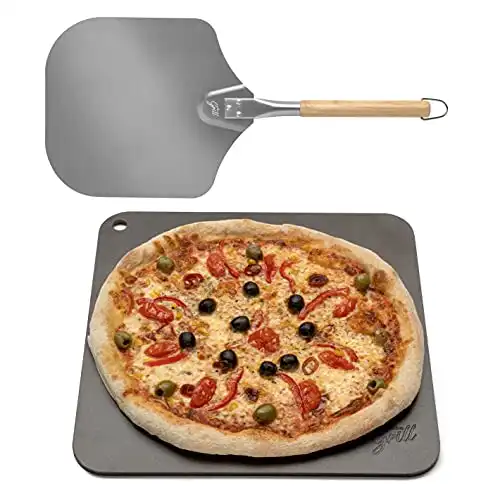
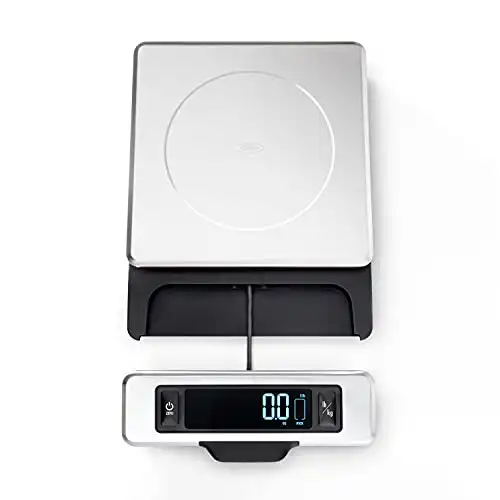
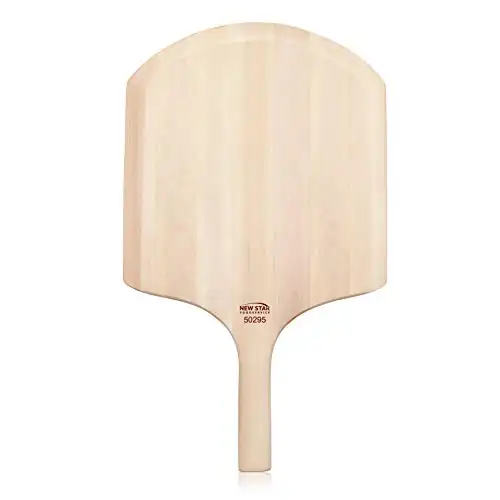
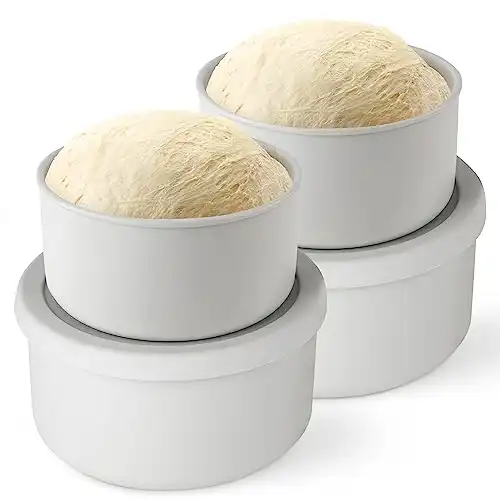
I just made this for the first time last week and, full disclosure, haven’t had a lot of experience making pizza at home. I made the full recipe, put dough into 4 separate bags and placed in the refrigerator for 3 days. I shifted them to the freezer from there as my (schedule didn’t allow me to make for several days. I removed one dough from the freezer on Saturday morning, placed in the refrigerator for about 8 hours and then on the counter 2 hours before trying to stretch it. I tried following the tips in the video you posted but it wouldn’t stretch. It kept bouncing back into the original ball shape. After many attempts to do it the right way, I finally rolled it with a pin. Even then it was stubborn to stretch, never got as thin as NY pizza and I definitely degassed it. Any idea what my issue was?
Hi Shana – it’s hard to say but probably guessing that the gluten was not sufficiently developed. How long did you knead it? By hand or mixer and what kind of flour did you use? There are so many variables..
I used the dough hook on a Cuisinart hand mixer. Do you recommend doing by hand instead? It’s possible I didn’t do it for the full 4 to 5 minutes as well so I’ll make that adjustment next time.
I use my dough hook too but using a kitchen aid. Sometimes with my mixer, the dough just spins around the hook and it not really being kneading so look out for that and adjust accordingly. 5 minutes is usually good
Hello Marie, I’ve just recently started making my own pizza at home and your recipe really inspired me. The only problem I’ve been having is that when the pizza comes out of the oven, there is a layer of raw flour on the finished product (from stretching). It leaves an unpleasant chalky aftertaste. How do you get passed this?
I would brush off extra flour before beginning to stretch out the dough. and if you are using a peel to transfer the dough make sure that the peel is well floured…hope that helps!
I’m confused. You say up front that “This recipe make four 14″ pizzas or can be halved to make two 14-inch pizzas.” Which is it, FOUR 14-inch pizzas or TWO 14-inch pizzas?
Hi Rick – the recipe makes 4 pizzas as written. If you use half of the ingredients listed in the recipe, you can make 2 pizzas instead.
Just amazing. I used a food processor instead of a mixer as a suggestion from another pizza article. Basically ran it to combine the ingredients. I don’t think I worked the dough for more than 2 minutes. Quartered, fridge for 3 days, and it was absolutely perfect. There were so many air pockets in the dough, I don’t think I’ve ever seen dough like it. Used a grill pizza stone at about 600 degrees. By far the best dough I’ve ever been able to make. This is a restaurant quality recipe without any modification. Great taste, great texture, not going to waste time with any other pizza dough recipe again. We had a family pizza competition, and this handedly beat everyone else’s dough including the one actual chef in our family.
Your comment really made me smile! Thanks for the feedback! 🙂
I just made the dough and put it in the frig. And I’m not for sure if I remembered to add the sugar. I think I did, but if I forgot, am I screwed?
HELP
No worries – it will still be fine without the sugar, but may be a little pale after cooking. The sugar helps the crust brown in the home oven setting. I’ve forgotten the sugar too before.
Thank you so much for this recipe. I have been doing my own version of “home made” pizza for a year or so but wanted to take it to a new level and WOW, this is the best yet! Even managed to stretch and shape my dough (very amateurishly!) after watching the video. This is so simple (the only difficult part was waiting 3 days for pizza!) and so good. My daughter said it is the best she’s ever had – amazing! Thanks again.
The 3-day wait is hard! I’ve used it after 1 or 2 days too. Glad you liked it:)
Do you just form the round pizza dough with your fingers?
Yes, but also similar to the video that is posted on the page
Thank you so much! I have been searching for the perfect pizza dough recipe and have finally found it thanks to you! The recipe seems quite forgiving too-I use active dry yeast and it seemed to work just fine. I also lost track of the amount of flour I was adding but just added enough to make a wet dough-sticky but not too sticky.The next day I made a test pizza and brought the result with me when I picked up my pizza obsessed daughter from school. She declared it to be the best pizza she has ever eaten! The crust is awesome-crispy,chewy,holey,yummy!
Truly cannot thank you enough-finally my pizza is as good as restaurant pizza!
thank you, Sheila!
Hi I just found this recipe the other day while searching for “easy pizza dough recipes” because I usually use pre-made bases and couldn’t find any at the store! I’ve tried a few dough recipes before only to have total failure (too chewy, dough crumbles apart, etc.) every time.
This is the first time I have made proper pizza dough and the flavour was AMAZING!!!!! not flavourless like every other recipe I’ve tried (and the icky pre-made bases!)!! Thank you so much! I will be using it again and again from now on, and will send it to everyone I know!
So I tried this recipe, and followed it to the T. It came out AMAZING! I have been making pizzas for a while now, and while they turn out good and tasty, never better than most pizza shops. Until now. Thanks Marie! One trick I do that might help others, I put two pizza stones in my oven, on two racks close to each other. I preheat the oven at 500 or 550 and put the pizza on the bottom one. The second stone really does a good job of cooking the top of the pizza while the lower one does what you would expect to the bottom.
Shane – that’s brilliant!! I’m going to have to try that – thanks for sharing that idea!
I am having an issue finding Instant Active Dry yeast in my local supermarket. There are only Rapid Rise and Active. I did find one that was made by Red Star called Instant Active Premium, but that doesnt sound like the right one either. Can I substitute? Is it known by another name by chance?
Hi Shane – see my email…
Rapid rise = instant.
Hi Marie!
I just wanted to ask whether i can make calzones or pizza pockets with this dough? Or basically anything which requires pizza dough? Or does this dough work best for this pizza only?
Also, can I make a slightly thick crust piiza with this dough??
Thanks for the recipe!
I adore you.
Love,
Urooj.
Thank you for your note – you made me smile! YOu can use this dough to make anything pizza dough -related, so yes, pizza pocket, calzones, etc. You can also make it thicker, sure. You would just have to adjust your cooking time, of course. Enjoy!
Hi Marie,
Thanks for this recipe. I have been looking for a good NY pizza recipe for years. I can’t wait to try it. You suggest not using pre shredded cheese. Should you grate your own cheese before placing it on the crust?
Hi Janice – I hope you like it! A good NY pizza also depends on proper baking. That is, high heat and using a baking stone or steel. With regard to cheese, I used to grate it fresh but I’ve been cheating lately and buying the pre-shredded (shhhh….our secret, k?) 🙂
Thanks so much! I have a great baking stone…it was just waiting for some great pizza dough! 🙂
Marie, I have tried many different doughs for making pizza and I am glad I found yours. It is the best I have tried so far. Last year I made an out door pizza oven and it takes me about 3 hours of burning wood to get the temperature of the floor to about 800+ degrees. I can do a pizza is about 3 minutes.
The thing that I have to ask you is in adding the olive oil. I mix everything that you stated in the order you state, (weighing flour, water) and when it all comes together and does not stick to the sides, I add the olive oil, I only add 2 teaspoons, and then everything sticks to the bowl, taking the dough out of the bowl is a mess and trying to make it into a 12″ shell is hopeless. Cannot form it and tears most of the time.
I have stopped adding the olive oil and now I brush it on after the shell is formed.
Any tips as to what I might be doing wrong? Every recipe I see most call for olive oil and some want 2-3 tablespoons, but of the others, yours is the BEST.
Hi David – it’s hard to say without seeing your exact process but one suggestion would be too try adding the oil earlier in the process. Maybe that will help. Also, mix more because if the dough tears, it’s usually a sign that the gluten hasn’t been developed enough. you could also try mixing flour and water first just until mixed, then let sit 20 min undisturbed. then add the other ingredients and mix for several minutes.
Thanks Marie, I will try that as I have to make some for this coming Saturday, celebrating our granddaughters birthday and all the grandchildren love the pizza and always rave on the taste of the dough. (so does everybody else)
Hi Marie, what type/brand of yeast do you use?
Hi Tara – I use instant mostly (redstar or SAF brand). I used to use active dry yeast but instant is more convenient for me. I’ve heard some people say that they prefer the flavor from the active dry as it promotes a slower proofing